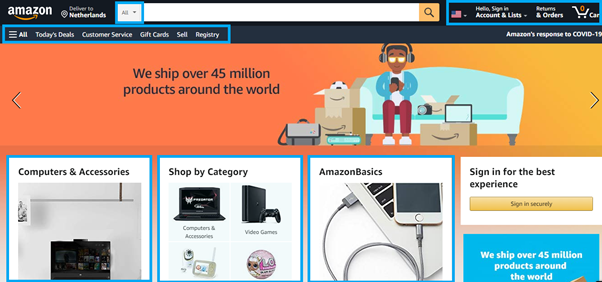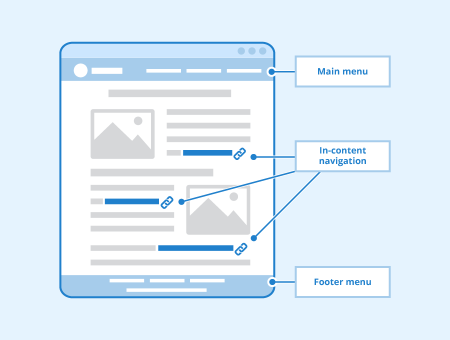Website navigation is a menu or group of menus that allow users to move between pages and makes it easier to find what they’re looking for. Although most people think of the main menu that’s usually found at the top of webpages when referring to website navigation, menus in the footer, sidebar, and even in the main content of a page all make up a website’s navigation structure.
Good navigation allows website visitors to find what they’re looking for quickly and effectively, improving the user experience of a website. A navigation structure that’s very unique or that doesn’t contain links to important pages on a website is less effective and can create a poor user experience.

An image of the Amazon homepage showing just some of the navigation features on the page highlighted in blue.
Website navigation affects a website’s performance in various ways, either positively or negatively. Among others, website navigation can affect the user experience of a website, the passing of “link juice” and the user signals/conversions.
User experience
By allowing website visitors to find the pages they are looking for and simplifying a user’s interaction with a website, a well-thought-out website navigation can be very beneficial to a site’s user experience.
Passing of link juice
Internal linking is a big part of SEO, and a good navigation structure can ensure page power is distributed more effectively.
Improving crawlability
Since search engine crawlers work by following links on a page, a website’s navigation plays a big role in the ability of crawlers to discover pages. This helps ensure search engine crawlers can reach every page and reduces the likelihood of orphan pages on the site.
User metrics/conversions
By improving usability and making it easier for users to find your products, services, and contact information, effective website navigation can improve the user metrics on your website, like the bounce rate, the number of page views, and the interactions with your pages, among others, as well as increase conversions.

There are a few common forms of website navigation, namely:
The main menu on a website is usually found at the top of every single page and contains the most important top-tier pages on a site. Links to the homepage, contact page, main service/product categories, blog, and other overarching pages are commonly found in this menu.
The footer menu generally contains links to the most important pages that were not added to the main menu. Common links in the footer menu are links to the terms and conditions page, FAQ pages, company information, social media links, and partner pages, among others.
In-content navigation can vary from internal links to small and large menus in the main content of a page. In-content links generally link to pages related to the content on the page.
Although there are certain links that are commonly seen in certain types of website navigation, the exact structure of the navigation and the links included depends on the website’s goals, its size, and the different pages it has.
Its relevance to SEO
Optimizing website navigation is an important part of SEO and digital marketing as a whole. Since a website’s navigation allows crawlers to discover pages and helps pass on page power, there are various direct SEO benefits that well-optimized website navigation has.
There are also some indirect benefits, like improved user metrics and an improved user experience, that can be gained by optimizing a site’s navigation. This can help your SEO performance as well as the performance of your overall marketing activity.
Related links
- https://www.searchenginejournal.com/technical-seo/website-navigation/
- https://www.smartinsights.com/user-experience/website-design/optimizing-navigation-menus-higher-effectiveness-conversions/
Similar articles
